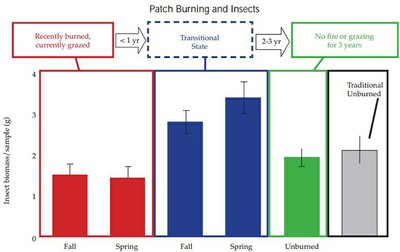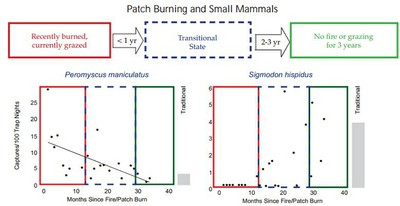Wildlife
The creation of diverse habitats for single or multiple animal species is the main benefit from patch burning (Figure 1, Table 1). Creating varied habitats increases the diversity of species on a given area (Figures 6, 7, 8). This increased diversity of habitats and species has the potential to increase recreational lease opportunities, along with aesthetic values of the area. Again patch burning gives control of invasive plant species, such as eastern redcedar (Juniperus virginiana) and sericea lespedeza which can be detrimental to many species of native wildlife.
Wildlife, regardless of species require some level of habitat diversity. Healthy wildlife populations cannot be maintained by monocultures of plants or structure that is uniform. So by mimicking natural disturbance processes across the landscape, we can create the appropriate mix of plant communities and structure that is necessary for the survival of various wildlife species. With patch burning the most important consideration for wildlife is the scale of disturbance. The timing or frequency of the burn should imitate historic fire regimes if overall biodiversity of native wildlife is the goal. If a specific species is of primary concern, then the timing or frequency of the fire may be altered to maximize production of that species.
The size of the burn should match the scale of the wildlife species being managed for. Northern Bobwhite (Colinus virginianus) require smaller patches than do whitetail deer (Odocoileus virginianus). By varying the size and the number of patches habitat for all species of wildlife can be optimized across the landscape. This illustrates how adaptive the patch burn system is, and how it can be modified to meet individual animal species and land manager objectives.
Figure 6. The range of habitats required by prairie songbirds. Does traditional management (homogeneity) practices meet all of the needs? Patch burning allows for multiple habitats (heterogeneity) within the same unit for multiple species.
Figure 7. Insect biomass compared between patch burn patches and traditional management. The greatest amount is found in the transitional states which are brood rearing areas for many bird species.
Figure 8. Number of captures of white-footed deer mice (Peromyscus maniulatus) and cotton rats (Sigmodon hispidus) between patch burn patches and traditional management practices. Again showing how important heterogeneity becomes from the patch level all the way up to the landscape for multiple species use.



